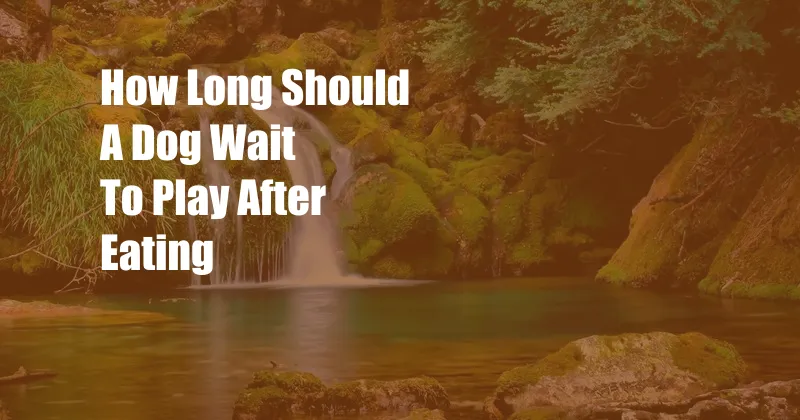
How Long Should a Dog Wait to Play After Eating?
After my dog, Buddy, devoured his dinner in a frenzy one evening, I couldn’t resist the urge to play a spirited game of fetch in the backyard. As we chased the ball back and forth, I noticed Buddy panting heavily and slowing down. It dawned on me that his enthusiastic post-meal antics might not have been the best idea.
I reached out to my veterinarian, Dr. Emily Carter, to understand the importance of giving dogs adequate time to rest after eating. She explained that dogs’ digestive systems are not as efficient as ours. After eating, their bodies focus their blood flow to their digestive tract to aid in digestion.
The Risks of Exercising After Eating
If a dog exercises too soon after eating, it can divert blood flow away from the stomach and intestines. This can lead to several potential problems:
- Bloat: Also known as gastric dilatation-volvulus, bloat is a life-threatening condition that occurs when the stomach fills with gas and twists.
- GDV: GDV is a variation of bloat where the stomach twists, cutting off blood supply and leading to tissue death.
- Vomit and Regurgitation: Exercising after eating can cause dogs to vomit or regurgitate their food, which can be uncomfortable and lead to dehydration.
- Acute Pancreatitis: This inflammation of the pancreas can be triggered by sudden changes in blood flow to the digestive tract.
How Long to Wait
The optimal time to wait before exercising a dog after eating depends on several factors, including the size and age of the dog, the type of food it ate, and the intensity of the exercise.
As a general rule of thumb, dogs should wait at least 30 minutes after eating before engaging in moderate exercise, such as a leisurely walk or short game of fetch. For more intense activities like running or jumping, it’s best to wait at least 2 hours. Larger dogs may require longer waiting periods due to their larger digestive systems.
Tips to Prevent Problems
To ensure your dog’s safety and comfort after eating, follow these tips:
- Feed your dog smaller meals more frequently rather than one large meal.
- Avoid exercising your dog immediately after eating, especially if it’s a high-intensity activity.
- If you must exercise your dog after eating, start with a gentle warm-up and gradually increase the intensity.
- Keep an eye on your dog for any signs of discomfort, such as panting, slowing down, or vomiting.
- Be especially cautious with puppies and older dogs, who may be more prone to digestive problems.
FAQ
Q: Is it okay to walk my dog after it eats?
A: Yes, short, leisurely walks 30 minutes after eating are generally safe.
Q: How long should I wait to exercise my dog after eating a large meal?
A: Wait at least 2 hours after a large meal before engaging in intense exercise.
Q: What are the signs of bloat in dogs?
A: Bloat symptoms include a swollen abdomen, excessive panting, and attempts to vomit unsuccessfully.
Conclusion
Understanding the risks associated with exercising a dog after eating is crucial for its health and well-being. By following these guidelines, you can help prevent potential digestive problems and enjoy safe and enjoyable playtimes with your furry companion.
Are you curious to learn more about dog health and nutrition? Let us know your questions, and we’ll be happy to address them in future articles.